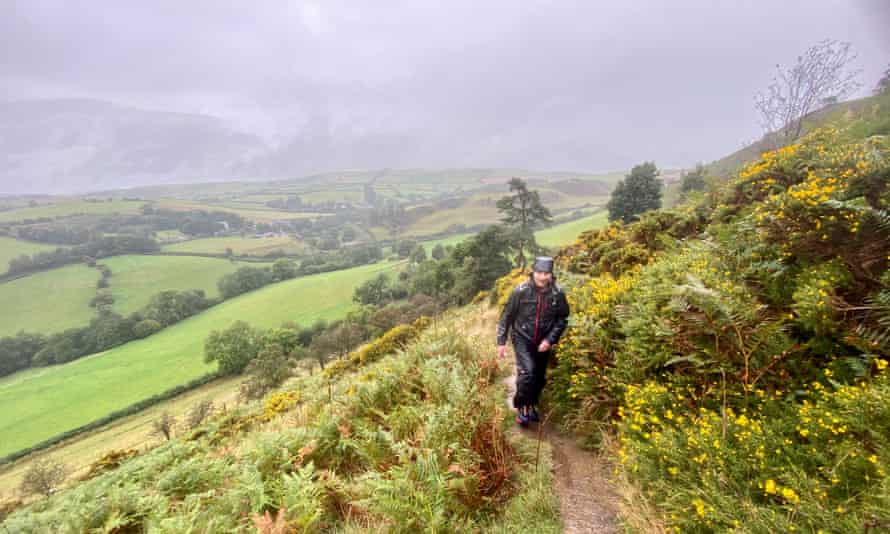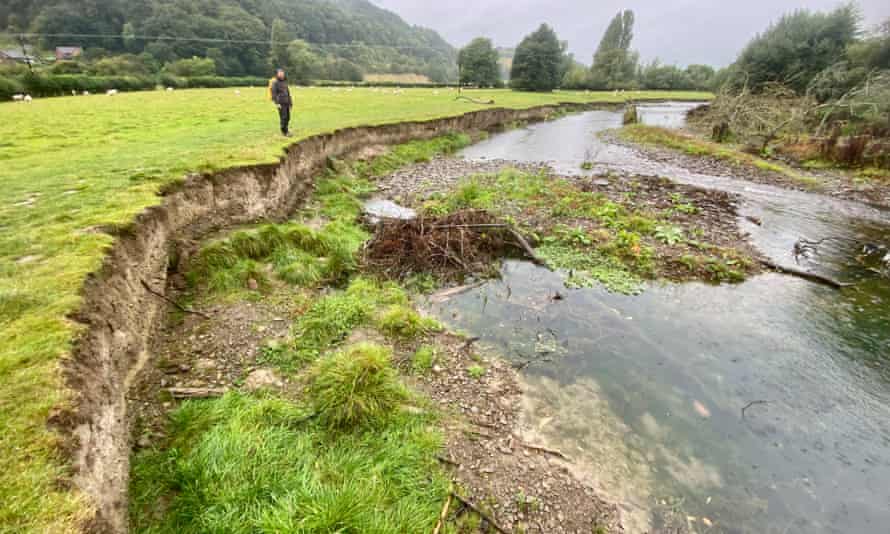We come up a steep hillside, stepping past twisted trees laden with lichen and scarlet berries, all dripping with rain. A mob of ravens clack overhead. Then, as we come out on the top, I understand at last what the fuss is about. Ahead is a bracken-covered rampart as tall as a house, curving forward into the mist, its steeper face turned west towards hills and valleys that are dimly visible through sheets of rain and cloud. “This is it!” shouts Rob above the noise of the downpour. “Look how it follows the contours, how they built it to impress anyone coming up from the west.”
I knew, of course, about Offa’s Dyke. I’d seen the photographs. It was the faint remains of an earthwork, like the wrinkled lip of England, running along the border between it and Wales, built by some medieval megalomaniac with a silly name. I had not expected this massive fortification, barging its way across the broad shoulders of Llanfair Hill, a few miles north of Knighton.

The path that accompanies the dyke is 50 this year and Rob Dingle, who has been its trail officer and custodian for the past 14 years, has watched as interest has steadily grown: as many as 3,000 walkers complete the 177-mile trail every year (usually taking about two weeks, although the record journey time is 52 hours, 26 minutes). The path, he says, does not always follow the historic dyke, leaving it where better views are to be had from the hills. “Like north of Llangollen,” he says. “There’s a brilliant section across the escarpment.” Ironically, while the path seems very secure in its status as a National Trail, the dyke is under constant threat: legal protection is patchy, and in addition to natural erosion, agriculture, developers and even walkers can cause damage – all problems we will encounter.
Today we are tackling what most walkers agree is the demanding sixth segment (assuming you arrive from the south, as most people do). From the town of Knighton, the path takes you across a series of steep hills, a rollercoaster of a ride all the way to Montgomery, 18 miles to the north. Not everyone comes prepared for the challenge. “I had one overseas walker write to complain that there were no rangers, no waterpoints and no defribrillators,” says Rob. Fortunately, most visitors love the simple isolation and lack of modern clutter. We meet a few of them during our day: Maylis, a French woman, who is walking around England; and Jack, from north Wales, who is running and walking Offa’s Dyke Path in five days. “I did Bangor to Cardiff,” he says. “Now I’m going the other way.” Usually, however, we are alone, either in cloud, or when it suddenly clears for a few minutes, in a vast Tolkienish landscape of rolling hills and distant peaks.

The path was one of the first of Britain’s 16 National Trails, a development that began after the second world war as part of a broader government campaign to open up the countryside to the public. With the soon-to-be-completed England Coast Path among them, these are the gold standard trails, well-marked and with salaried trail officers to watch over them. Offa’s Dyke Path is now served by a number of local hotels and B&Bs, whose drivers will often pick up walkers where they finish and drop them back at the same spot next day – it’s a useful service when attractive towns such as Bishop’s Castle or Clun are a few miles off the route.
We reach the trig point on Cwm-sanaham Hill, at 409 metres, with a great panoramic view west towards the railway viaduct at Knucklas. The mist and cloud drifting across the landscape seem entirely appropriate, as this ancient earthwork is permanently shrouded in mystery. It is said that King Offa of Mercia had it built in the late 8th century to protect his kingdom, but this is a defensive structure without forts, towers and any of the infrastructure you would expect. Professor Keith Ray of Cardiff University believes it was designed to flaunt power and capability: “It’s a monument to a vainglorious king who wanted to impress.”
Ray and his team have used lidar (laser scanning) and drones to discover about 12 miles of previously undetected dyke. “We’ve found that it ends, as it begins, with a brilliant flourish. There’s also a wonderful new section where it crosses the river Alyn near Mold.” With such discoveries, the old belief that the dyke never actually stretched from sea to sea (Liverpool Bay in the north and the Severn Estuary in the south), is being replaced by a new vision of a much larger and more important monument.
Offa himself had battled his way to supremacy in southern England and was clearly well connected internationally (a gold coin bearing his image from AD774 is inscribed in Arabic). His ambition was to expand Mercia and assert its dominance. “If he’d succeeded,” says Ray, “the English might call themselves Mercians now.” In fact, within a generation of Offa’s death in AD796, the kingdom was defeated by the rising power of Wessex. The first written record of the dyke is in a biography of King Alfred from a century later, in which the author, a Welsh monk called Asser, describes Offa as “a vigorous king who terrified all the neighboring kings”.

Back on the path, we descend and climb again, sometimes even walking on the ridge of the berm. Will that damage it? “There are threats,” says Rob, “We’re trying to move the route off the actual dyke, where it’s causing erosion – like on steep slopes.” One might assume that, having survived for more than 1,000 years, the dyke is unlikely to disappear, but the damage accumulates. Larch trees planted on the dyke get blown over, creating root holes. Gorse bushes allow rabbits to take cover and dig burrows. Worst of all, a plough or a digger can wreak havoc in a few hours. “It’s not malicious,” says Rob, “but it can be devastating.”
As we walk uphill from the River Clun, we find someone has dug a septic tank into the dyke. Plastic pipes poke up from what is one of Britain’s greatest ancient monuments. Rob looks shaken. It’s hard to protect the dyke without local support and understanding. For Ray the answer is simple: “It ought to be a world heritage site. That would put an end to the casual damage and nibbling away.”




